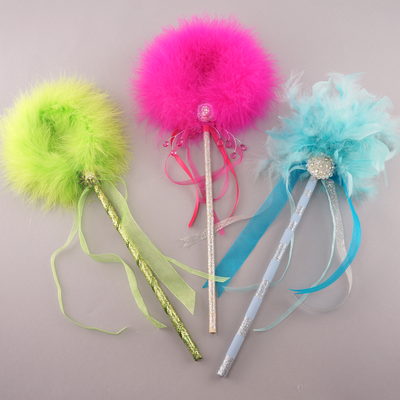Halloween Costume Horns
Get scary and spooky this Halloween with your horns. Guest contributor Danielle sent us a step-by-step guide on how to make these costume horns. Be something crazy this holiday.


Materials:
- A cookie sheet for baking
- One 2oz package of non-toxic polymer clay in the desired color for solid color horns
- A smooth, clean board or acrylic sheet to work on (alternatives: an old, clean cooking sheet-uncovered, a scrap of tin, a vinyl remnant from the fabric store. Anything flat, smooth, and expendable.)
- Clay drill or a metal or bamboo skewer
- .8 or 1 mm clear beading elastic (nothing smaller as it will not be strong enough)
- Masking tape
- Clay working tools
- Brush-on gloss glaze (optional)
- Wide bristle art brush
- Tin foil
- Aluminum clay knife or pastry knife
- Scissors
- Superglue
- Oven or Toaster Oven
- Paper towels
Warning:
- Do not eat while working this project as the clay will leave a residue on your work surface and your hands. While the clay is non-toxic, you still don't want to ingest it with your food. This project should be done with adult supervision if being completed by children and is not recommended for children under five or those who have the impulse to put things in their mouths.
- Make sure the kitchen is well ventilated when you are baking the clay. It does produce strong fumes that you do not want to inhale too extensively. Open a window or turn on a fan, and do not wait in the kitchen while the items are baking.
- The smell of the fumes will linger in your oven for a short time after you've baked the horns. It will cook off and dissipate rather quickly, but if you use your home oven that you prepare food in, you might want to run it without anything in for a some time after to get rid of the smell sooner or run the cleaning feature if you have one. An alternative to that, if you are going to be working with polymer clay on an ongoing basis is to purchase an inexpensive toaster oven for dedicated clay use. I keep mine in the garage and do all my baking there. You would need a toaster oven that lets you set to a specific temperature and it is beneficial to have one that lets you set a timer. Mine actually has a timer that will turn off the unit rather than just alerting me that it is done, which is absolutely wonderful.
Preparation:
- Place your work board on the table or counter you will be working on and use the masking tape to secure it in place. I used an acrylic sheet to work and roll out my clay as it is easier to clean and will not suffer from color transfer. Do not use paper as the clay will stick. Aluminum foil would work in a pinch, but can tear while you are working. If you decide to work directly on the table or counter surface I would recommend choosing. If you use an old cookie sheet make sure it is one you will NOT use for food preparation from that point on.
- Wrap cookie sheet in tin foil and set nearby.
- Select your clay and remove the cellophane. If you are making just one set of horns you can cut off only the amount needed and minimize how much you must work, if you are making them in bulk best to just work the whole thing. Start to knead and work the clay until is more malleable. Roll it between the work surface and the palm of your hand, or just between both hands, until it is smooth and there are no seams. You should end up with a ball or a rope of clay.

- Use your clay knife to slice off enough clay for the approximate size horn you desire, then slice a second segment the same length, make sure that the sections are roughly the same amount of clay.

Steps:
- Once you have your clay start working it into the horn shape you desire by sculpting it with your fingers and tools (see below). Make sure the base is both flat and a bit wide for stability.

- When you have your horn in the proper shape take your clay drill or skewer and very carefully pierce the side of your horn until it goes all the way through. This hole is for the elastic that will hold the horns onto the head. Be sure to smooth the edges of the hole where the clay pushes out, but don't press too hard or you will close up the opening. Repeat on the other horn, making sure that the holes are in the same orientation.

- When complete place the horns on the cookie sheet and either move on to baking, or create more sets of horns. Make sure the horns are in the upright position as much as possible any surface touching the pan will flatten and take on a glossy finish in reaction to the foil.

- Set your oven or toaster oven to 275 degrees. (do not set higher).
- Set your timer to 25 minutes. (package recommends 15 minutes for every ¼ inch of depth but I find 25 minutes is sufficient for my horns no matter the size).
- Once the temperature is up to speed slide the cookie sheet into the oven, making sure the horns do not touch the sides if you are using a toaster oven, in those instances where you are making many sets at once.
- Activate the timer.
- Once the horns are done baking remove them and set them aside to cool. Do not touch them until they are completely cool as the clay will be very hot and will not completely harden until cool.
- (optional) take the brush-on gloss and glaze your horn. It will give it a bit of a protective surface and it will also bring out the colors, which dull and darken a bit after baking; or, for effect, glaze only part in a pattern, such as with spiral horns. Let them dry completely before handling. You may need more than one coat and be sure to get all spots if you are not purposely only glazing part of the surface.

- Take the elastic cord and measure it to fit your head, leaving a little extra so you can tie it off. Don’t make it too tight, just enough to hold the horns firmly in place.
- String the horns on the elastic, making sure that they are both in the same orientation, then holding both ends of the elastic together, make a double knot.

Pull the elastic very tight from both sides, then place a drop of super glue on the knot to ensure it will not unravel. Trim off any excess. If you discover you have tied it too loose, just repeat the process a little above the existing knot. You do not want it tight enough to press into your skin, but the horns should rest in place without shifting. If it is too tight you will have to cut the elastic and try again.

- Leather or cloth cording can be uses in place of the elastic, but they will be more visible. If you chose this route trying and find something close to the hair color of the person that will be wearing the horns.
- If the person wearing the horns has an issue with things tied around their head you can skip drilling the hole and use craft glue to attach the horns to a bandana (cut holes, poke the horns through, and then glue on the underside), to a headband, or to a hat. You could also connect directly to a wig.
For other types of horns and ideas check it out here!
Read NextBaby Bat Crochet Costume
















